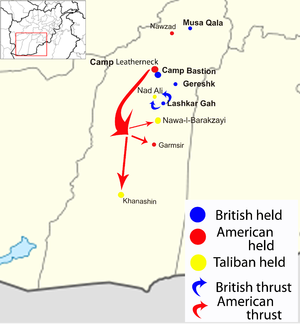
Back Operation Strike of the Sword German Operación Golpe de Espada Spanish Opération Strike of the Sword French Operazione Khanjar Italian Operasjon Strike of the Sword NB Operação Golpe de Espada Portuguese Операция «Ханджар» Russian Qilich zarbasi operatsiyasi UZ 彎刀攻擊行動 Chinese
| Operation Strike of the Sword | |||||||
|---|---|---|---|---|---|---|---|
| Part of the War in Afghanistan | |||||||
 Operation Strike of the Sword in red; Operation Panther's Claw in blue | |||||||
| |||||||
| Belligerents | |||||||
|
|
| ||||||
| Commanders and leaders | |||||||
|
|
| ||||||
| Strength | |||||||
|
| Unknown | ||||||
| Casualties and losses | |||||||
|
| At least 49–62 killed[5][6] | ||||||
Operation Strike of the Sword or Operation Khanjar was a US-led offensive in Helmand province in southern Afghanistan. About 4,000 Marines from the 2nd Marine Expeditionary Brigade as well as 650 Afghan troops were involved, supported by NATO planes. The operation began when units moved into the Helmand River valley in the early hours of July 2, 2009. This operation was the largest Marine offensive since the Battle of Fallujah in 2004.[7] The operation was also the biggest offensive airlift by the Marines since the Vietnam War.[8]
The Marines pushed into primarily three significant towns along a 75-mile stretch of the Helmand River valley south of Lashkar Gah. At least two Marine infantry battalions and one Marine Light Armored Reconnaissance (LAR) battalion spearheaded the operation. In the north, 2nd Battalion, 8th Marines (2/8) pushed into Garmsir district. In central Helmand, 1st Battalion, 5th Marines (1/5) pushed into Nawa-I-Barakzayi to the south of Lashkar Gah, 2nd Light Armored Reconnaissance Battalion (2nd LAR) entered Khanashin in the Khan Neshin district.[9][10][11]
- ^ "Taliban launch 'operation' against U.S. Marines | World Military Forum – Latest Military News | Army, Navy, Air Force, Missiles". Archived from the original on 2012-03-01. Retrieved 2009-12-05.
- ^ Taliban scatter in Afghanistan, but the threat survives – TwinCities.com
- ^ ReliefWeb ť Document ť Factbox – Security developments in Afghanistan, 16 Jul 2009
- ^ Coghlan, Tom (2009-08-01). "Battle stations anatomy of an ambush by the Taleban". The Times. London. Retrieved 2010-05-20.[dead link]
- ^ Cite error: The named reference
WP0703was invoked but never defined (see the help page). - ^ Battle of Dahaneh
- ^ "Obama Launches First Major Offensive in Afghanistan". US News. 2009-07-02. Retrieved 2009-07-04.
- ^ Sheppard, Ben (July 1, 2009). "US Marines storm south in major Afghan offensive". Archived from the original on 2009-07-11. Retrieved 2009-10-04.
- ^ Shanker, Thom; OPPEL Jr, RICHARD A. (2009-07-03). "In Tactical Shift, Troops Will Stay and Hold Ground in Afghanistan". NY Times. Retrieved 2009-07-06.
- ^ Sheppard, Ben (2009-07-03). "US Marines battle on in Afghanistan". The Sydney Morning Herald. Retrieved 2009-07-04.
- ^ "Operation Khanjar restores government control in Khan Neshin". ABC. 2009-07-06. Archived from the original on July 9, 2009. Retrieved 2009-07-06.